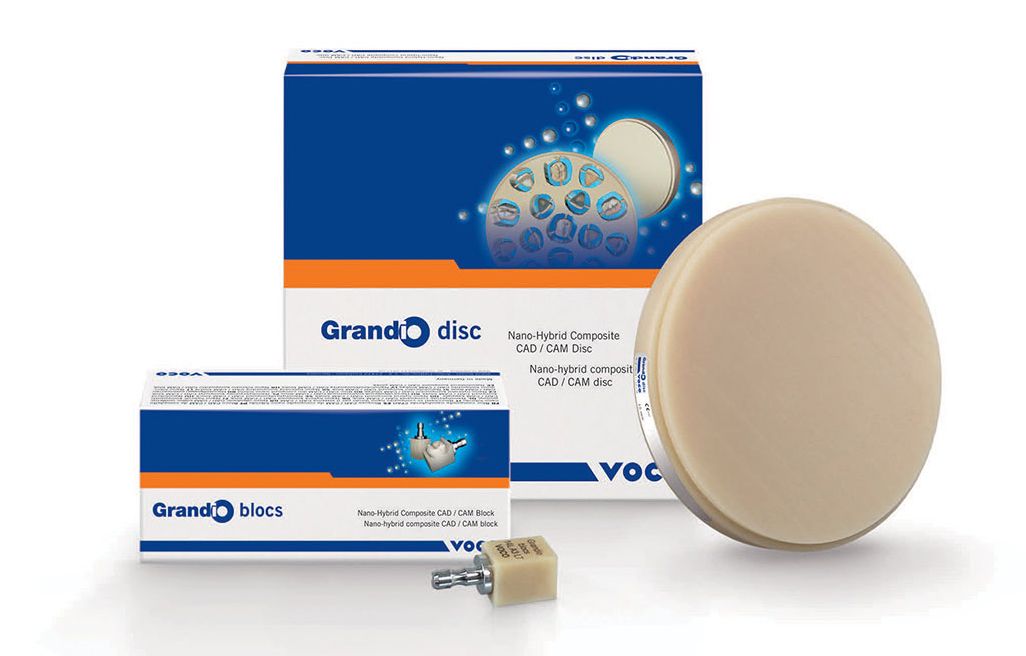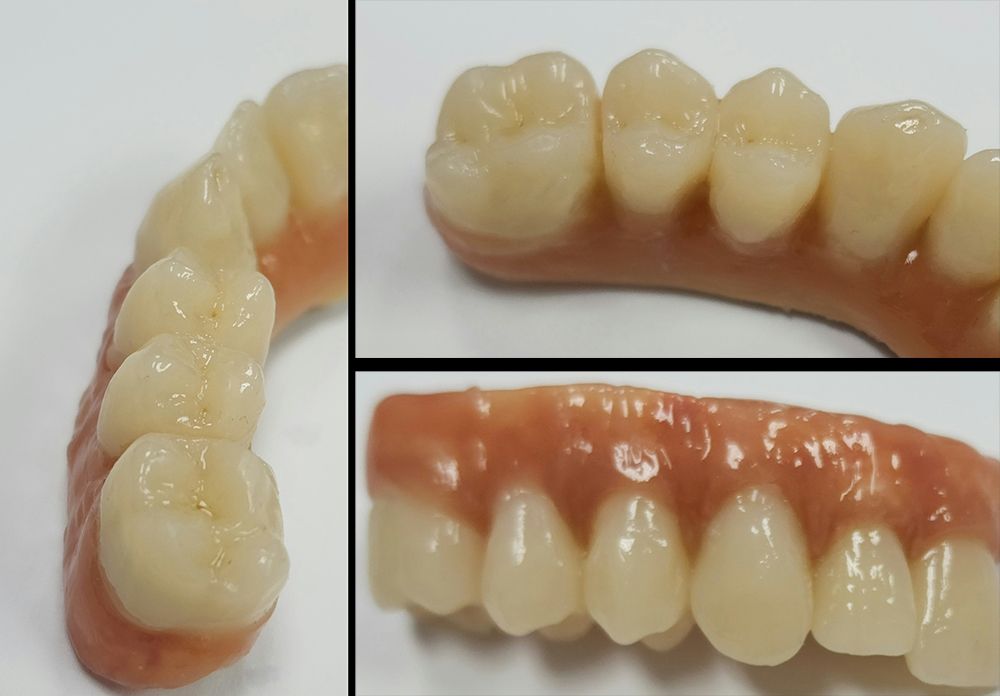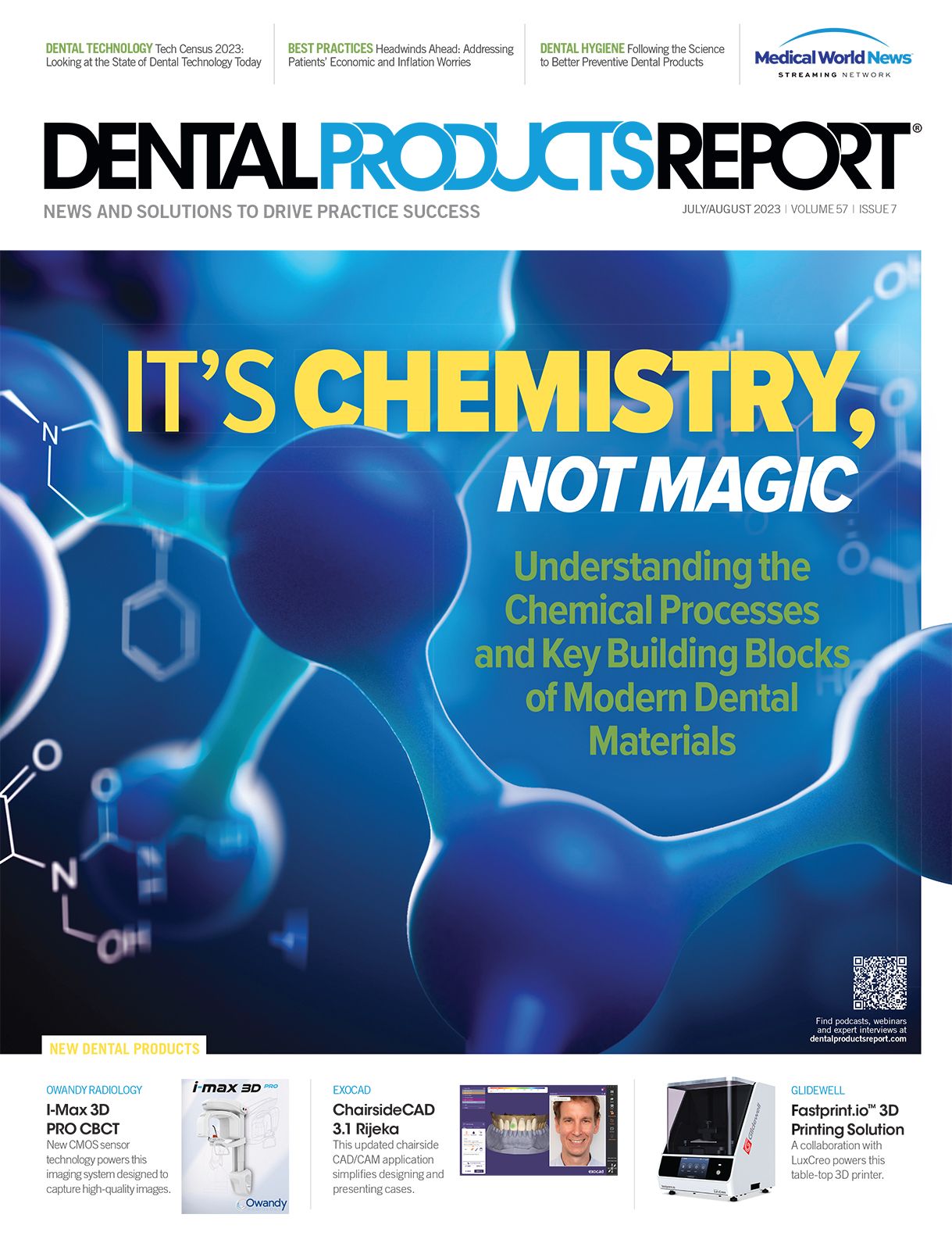As a third-generation dental lab technician, John “Johnny O” Orfanidis, CDT, has experience with more than just a handful of dental materials. He’s seen a parade of novel options come and go from the lab bench, and he’s always been focused on pushing the boundaries to produce the best restorations as efficiently as possible.
Indicated for crowns, inlays, onlays, veneers, and implant-supported crowns, Grandio disc is an 86%-filled nano-ceramic hybrid CAD/CAM disc said to offer a combination of optimal tooth-like physical properties, category-leading compressive strength, extremely low water absorption and natural esthetics with enhanced color stability. The material provides excellent polishability and esthetics, and enhances production efficiency by eliminating the need for post-mill firing or curing.
VOCO America Inc
Johnny O stays at the forefront of the industry by making sure he’s up-to-date on both the latest material science and the most innovative production technology and workflows. He built a reputation as a leading expert on dental zirconia, but for the past several years, he’s been working with a new material—the Grandio disc from VOCO—and he’s just as excited about the possibilities of working with this nano-ceramic hybrid material as he was when he first started with zirconia.
What makes the Grandio disc—and the chairside version, Grandio blocs—such an exciting material is its combination of toothlike physical properties, consistent and customizable esthetics, and streamlined fabrication workflow. The Grandio disc is not the only hybrid ceramic available for CAD/CAM production, but Johnny O says it’s the first product that truly brings the benefits of chairside composite materials to the lab bench.
The Grandio disc demonstrates a higher fracture force and flexural strength than other materials of the same type. At 86% by weight, it is formulated with the highest filler content of any CAD/CAM nano-ceramic hybrid material. Like chairside composites, the Grandio disc also provides consistent esthetics and, even more importantly, it offers a modulus of elasticity and a coefficient of thermal expansion similar to that of natural teeth, so restorations fabricated using the Grandio disc behave more like the structures they’re replacing. “When you understand what’s in it, [you realize] the opportunities it presents clinically and from a workflow perspective. This is where we’re headed,” he says.
Although patients can benefit from the physical properties of the Grandio disc, clinicians and dental labs will appreciate the efficient production workflow it offers. The material does not require any postproduction firing or curing, and Johnny O says, it polishes easily and retains its finish. In addition, if a Grandio restoration is chipped, it can be quickly and easily repaired intraorally using dental composite.
These properties attracted Johnny O’s attention because he’s seen how dental composites have become the go-to material for direct restorations, and he likes having a similar material option to work with in his lab. He believes there is a boom in what he’s calling “polymer dentistry” on the way, and the Grandio material is helping him get a head start for his lab.
The discs are available in monolithic shades, and milled restorations can be customized using an approach that is similar to customizing ceramic restorations. VOCO’s GrandioSO composites can be used while customizing a Grandio disc restoration, and because they are all from VOCO, these direct composites provide an identical shade match. Johhny O says VOCO’s reputation for making some of best chairside materials was a big reason he expected the Grandio disc to be an innovation to watch for. “When I started using it, it was great, because I knew “it was backed by extensive research and development,” he says. “It has a higher glass filler content [and] it has all the characteristics I like. That’s why I use it.”
Johnny O says he still sees a major role for zirconia in dentistry, but not every case needs that hard of a structure, which is becoming especially apparent as more and more cases involve dental implants. Although zirconia is durable and offers many other desirable physical characteristics, its strength can also present challenges when it comes to long-term function in the oral environment. This is why a more flexible material, such as the Grandio disc, that is kinder to opposing dentition is an ideal option for labs and practices today.
“When we have the opportunity to speak with doctors who understand material science at a different level, they’re willing to try some of these new materials because they’re putting that engineering and material science together, and they [realize that] there has to be a better way,” he says. “You have this solid chunk of zirconia on an implant part, with a screw in the bone. There are no ligaments, there’s nothing. It’s actually hard on the environment.”
The Grandio disc has become a go-to material for Johnny O when fabricating overstructures, and he likes that the material can be bonded to substructures fabricated from zirconia or other materials. This allows him to provide clinicians with a highly esthetic restoration made from materials that better approximate the physical properties of natural dentition.
“The polish is great. It has a beautiful smooth surface that gives you long wear because of the way the material is put together. More importantly, it has a little bit of flexibility to it,” he says. “For example, enamel does not have flexibility, but the rest of the tooth does. This gives you that tiny bit of flex you would need, and I really believe that’s going to be the next era of dentistry in the next few years. It’s going to be composite dentistry, and we’re just getting good at it.”
Another benefit of Grandio CAD/CAM materials is their repairability. Johnny O says this property often goes unnoticed, but having a restoration that can be repaired using standard dental composite is a huge advantage for patients. This means if something damages a Grandio restoration, the patient can have the issue fixed quickly from almost any dental office.
Although he’s quick to talk up the benefits of Grandio CAD/CAM materials, Johnny O notes that there’s a bit of a learning curve with milling the discs or blocs. He says the dense material mills more slowly than other materials he uses, and it produces a very fine powder. Still, most dental mills are compatible with the Grandio disc and are up to the task, and Johnny O says longer milling cycles are offset by other time savings during production.
“As you’re milling it, your offsets have to be a little different to make sure they fit,” he says. “When it comes out, it’s great. All you [have to] do is polish it. You don’t have to put it in an oven, and you don’t have to cure it for an extra amount of time to process it. Once you get your settings right, it’s a really nice material.”
However, as with everything he uses in the lab, Johnny O does see some room for improvement when it comes to the Grandio materials. He says the esthetics are great, but with US fashion trends pushing for whiter and brighter teeth, having a “super white” shade of the material would be helpful. Additionally, Johnny O says a thicker disc option would be another useful Grandio CAD/CAM option. “That would make a superb addition to the line of products,” he says.
That being said, Grandio discs and blocs fit the bill for what clinicians want in their CAD/CAM materials, Johnny O says. He believes dentists want seating appointments to be smooth and efficient, with a crown that drops right in, looks great, and can be bonded or cemented as the case dictates and the clinician prefers. As more evidence shows the benefits of using materials that are kinder to opposing dentition, Johnny O believes clinicians will increasingly request materials like Grandio. “I think doctors are going to drive demand [as] we start seeing a few more studies come out on hardness or toughness of materials,” he says.


